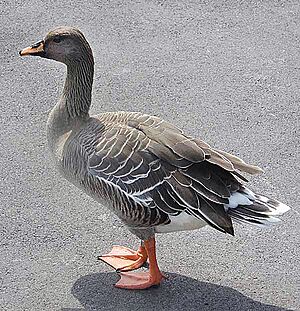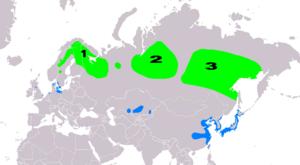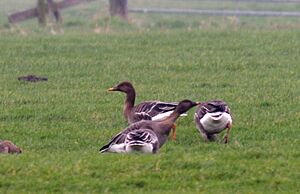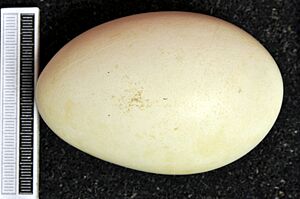Taiga bean goose facts for kids
Quick facts for kids Taiga bean goose |
|
|---|---|
 |
|
| Bean goose at Slimbridge Wildfowl and Wetlands Centre, Gloucestershire, England | |
| Conservation status | |
| Scientific classification | |
| Genus: |
Anser
|
| Species: |
fabalis
|
 |
|
| Range of A. fabalis Breeding Passage Non-breeding | |
The taiga bean goose (Anser fabalis) is a type of goose. These birds live and have their young in northern Europe and Asia. They are migratory, which means they fly south to warmer places in Europe and Asia for the winter.
Some experts, like the American Ornithological Society, see the taiga bean goose and the tundra bean goose as different species. However, other groups consider them to be the same species, often just called the "bean goose." These two types of geese became separate about 2.5 million years ago. Later, around 60,000 years ago, they met again and started to mix their genes.
What Does the Taiga Bean Goose Look Like?
The taiga bean goose is a medium to large bird. It can be anywhere from 68 to 90 cm (27–35 in) long. Its wings can spread wide, from 140 to 174 cm (55–69 in). These geese usually weigh between 1.7–4 kg (3.7–8.8 lb).
Male geese of the main type (called the nominate subspecies) weigh about 3.2 kg (7.1 lb). Females are a bit lighter, averaging 2.84 kg (6.3 lb). Their bill (beak) is black at the top and tip, with a bright orange band in the middle. Their legs and feet are also bright orange.
The feathers on the upper part of their wings are dark brown. This is similar to the white-fronted goose and the lesser white-fronted goose. However, the taiga bean goose has thin white edges on these feathers, which makes them look different.
The taiga bean goose makes a loud honking sound. Smaller types of this goose have a higher-pitched honk.
The pink-footed goose is a close relative. It has a shorter bill that is bright pink in the middle. Its feet are also pink. The feathers on its upper wings are a bluish-grey, much like the greylag goose. The pink-footed goose is very similar in size and bill shape to one type of taiga bean goose (Anser fabalis rossicus). Because of this, it was sometimes thought to be a sixth type of bean goose in the past.
Naming and Types of Taiga Bean Geese

The name "bean goose" comes from a habit these birds used to have. In winter, they would often eat leftover beans in farm fields. The scientific name Anser fabalis also relates to this. Anser is the Latin word for "goose." Fabalis comes from the Latin word faba, which means "broad bean."
There are three main types, or subspecies, of the taiga bean goose. They vary in size and the shape and color of their bills. Generally, the geese get bigger as you go from north to south and from west to east.
- A. f. fabalis (Latham, 1787): This type lives from Scandinavia east to the Ural Mountains. They are large geese with a long, narrow bill that has a wide orange band. This specific type of taiga bean goose is protected by an agreement called the Agreement on the Conservation of African-Eurasian Migratory Waterbirds (AEWA).
- A. f. johanseni (Delacour, 1951): Found in the West Siberian taiga. These are also large geese. Their bill is long and narrow, but it has a thinner orange band.
- A. f. middendorffii (Severtzov, 1873): This type lives in the East Siberian taiga. They are very large geese. Their bill is long and strong, with a narrow orange band.
Where Do Taiga Bean Geese Live?
The taiga bean goose is not very common in Britain during the winter. There are two main places where they regularly spend the winter. One is in the Yare Valley in Norfolk, England. The other is in the Avon Valley in Scotland. A group that used to visit Dumfries and Galloway no longer goes there.
The taiga bean geese that spend winter in Europe travel along three different paths, called flyways. These are the Western, Central, and Eastern flyways. Scientists have confirmed these paths by studying the feathers of the geese.



